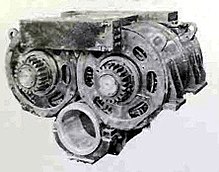Twin engine
The twin motor , known as the twin motor , is a type of electric motor that was used particularly in electric locomotives in the 1930s.
Structure and history
The traction motors of twin motors are designed in such a way that the armatures of two traction motors are mounted in a common casting . They were developed in order to use two smaller motors with lower power and smaller dimensions instead of one motor with a large output. Twin motors were used in both rod-drive and single-axle locomotives and were designed to save space and provide more power. In the middle of the housing shared by the two armatures was the large gear driven by the pinions of both armatures . The manufacture of a twin motor required a very precise casting with an exact location of three centers (two pinions and a large wheel). The advantage of using twin engines was that there was more space in the engine room of the locomotive, the disadvantage was the low center of gravity and the two double anchors.
Application with examples
Since the single-axle drive was not really trusted with the first electric locomotives with a higher output, only electric locomotives with a motor and rod drive were initially developed. As with the Prussian EP 235, locomotive motors with a stand diameter of up to 3.7 m were created to achieve the required performance . Maintenance turned out to be a problem. Therefore efforts were made to replace these single motors with a combination of two motors with the same rod drive. Some locomotives had a combination of two single engines ( E 32 , E 79 ), in the majority the version with twin engines was used ( E 52 , E 60 , E 91 ).
The situation was similar for locomotives with single-axle drive, here the application was limited to the spring cup drive due to the design . Even the first locomotive of the Deutsche Reichsbahn with a single axle drive, the DR series E 21.0 , was equipped with this type of drive and twin motors. The E 17 , E 19 11 + 12 and the Prussian EV 6 mso originally procured for the Altona port railway were built after it. Regardless of whether the locomotives were designed as bogie locomotives or frame locomotives , the twin motors were permanently mounted in the frame of the bogie or the locomotive. The drive was transmitted via the large wheel mounted on the hollow shaft. Other railway administrations also used twin motors, for example the E 656 of Ferrovie dello Stato Italiane had a twin motor for direct current .
It is not easy to make a direct comparison between a single-axis drive with single motors or twin motors. The E 19 0 had four individual engines, the E 19 1 had four twin engines. Both types have roughly the same performance. The E 19 1 was considered the most powerful German locomotive with a maximum output of 5,700 kW at 162 km / h until 1965. More recently, the required power can be provided by one motor per axis with much smaller external dimensions.
literature
- Wolfgang Messerschmidt: Locomotive technology in the picture - steam, diesel and electric locomotives . Motorbuchverlag Stuttgart, 1991 ISBN 3-613-01384-3 ; Pp. 109-111
- Dieter Bäzold, Günther Fiebig: Railway vehicle archive Part 4: Electric locomotive archive. 6th edition, Transpress Verlag, Berlin 1987; ISBN 3-344-00173-6
Web links
- Siemens description of an alien solution of double motors
- Description on a Swiss website about the design of twin motors in the bogie
- Description of twin engines on a book about electric mainline locomotives
Individual evidence
- ↑ Description of twin engines in the book about electric full-line locomotives
- ↑ Internet site on turntable-online with photo of the drive motor of the Prussian EP 235 | EP 235
- ↑ a b c d Dieter Bäzold, Günther Fiebig: Railway vehicle archive Part 4: Electric locomotive archive. 6th edition, Transpress Verlag, Berlin 1987; ISBN 3-344-00173-6 , description of the series concerned
- ↑ Wolfgang Messerschmidt: Locomotive technology in the picture - steam, diesel and electric locomotives . Motorbuchverlag Stuttgart, 1991 ISBN 3-613-01384-3 ; P. 110


